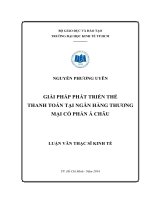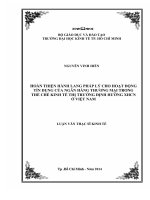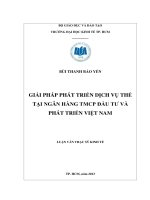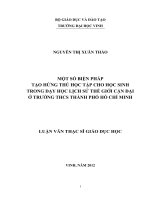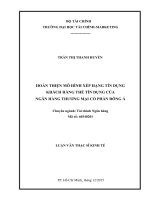The relationship between firms payout ratio, dividend yield and expected earnings growth luận văn thạc sĩ
Bạn đang xem bản rút gọn của tài liệu. Xem và tải ngay bản đầy đủ của tài liệu tại đây (482.13 KB, 66 trang )
MINISTRY OF EDUCATION AND TRAINING
UNIVERSITY OF ECONOMICS - HOCHIMINH CITY
LE ANH TU
The Relationship between Firm’s Payout
Ratio, Dividend Yield and Expected
Earnings Growth
-A Case Study for Listed Firms in HOSE and HNX-
MASTER’S THESIS
Ho Chi Minh City -2012
MINISTRY OF EDUCATION AND TRAINING
UNIVERSITY OF ECONOMICS - HOCHIMINH CITY
LE ANH TU
The Relationship between Firm’s Payout
Ratio, Dividend Yield and Expected
Earnings Growth
-A Case Study for Listed Firms in HOSE and HNX-
Major: Master of Business Administration
Code: 60.34.05
MASTER’S THESIS
Supervisor: Dr. Vo Xuan Vinh
i
Master thesis by Le Anh Tu
Supervised by Dr. Vo Xuan Vinh
University of Economics, Ho Chi Minh city- December 2012
I am grateful to Dr. Vo Xuan Vinh for his good insights and useful comments. His
experience and professionalism have certainly improved my research.
ii
Abstract
The relationship between the payout ratio, dividend yield and the expected earnings
growth was investigated for listed firms in Vietnam stock market, specifically firms
listed on the HOSE and HNX stock exchanges. This research is based on the model
developed by Arnott and Asness (2003).The research outcomes are as follows. Firstly,
there is a positive relation between the dividend payout ratio and future earnings
growth. Secondly, this research is an extension of the research done by Arnott and
Asness (2003). It was shown in this research that the payout ratio is positively related
to the expected future earnings growth for the individual listed firms in the Vietnam
stock market. Afterwards, an expanded model with some other variables was
constructed to forecast the expected earnings growth. As a result, only two variables,
payout ratio and dividend yield, were found to be significant within the expanded
model. Overall, this research is unique because we have focused on Vietnam stock
market -listed firms.
iii
Table of content
Acknowledgement .................................................................................................. i
Abstract .................................................................................................................. ii
List of tables ........................................................................................................... vi
List of figures ......................................................................................................... vii
Abbreviations ......................................................................................................... viii
Chapter 1: Introduction ....................................................................................... 1
1.1 The context of the Research .................................................................... 1
1.2 Structure of this paper ............................................................................. 2
Chapter 2: Current state of literature & Hypotheses Development .................. 4
2.1 Reason to Pay Dividends ........................................................................ 4
2.2 Dividend Returns ................................................................................... 5
2.3 Dividend Life Cycle Theory ................................................................... 5
2.4 The Dividend Decision Model by Lintner (1956) ................................... 7
2.5 Types of Dividend Payments ................................................................. 8
2.6 Stock Repurchases ................................................................................. 9
2.7 Preference for Dividends ........................................................................ 9
2.8 Relationship between Dividend and Profitability ................................... 11
2.9 The payout ratio predicts future earnings growth ................................... 13
2.9.1 Gordon’s Constant-Growth Valuation Model ............................... 13
2.9.2 Main conclusions by Arnott and Asness (2003) ............................ 14
2.9.3 Some Explanations for the Positive Relationship by Arnott & Asness
.............................................................................................................. 15
2.10 An extension of Arnott’s and Asness’s Research ................................... 16
2.11 Hypotheses Development ...................................................................... 17
2.11.1 Hypothesis 1 ................................................................................ 18
iv
2.11.2 Hypothesis 2 ................................................................................ 18
Chapter 3: Data & Methodology ......................................................................... 20
3.1 Introduction ........................................................................................... 20
3.2 Panel data analyses ................................................................................. 20
3.2.1 Sample construction ...................................................................... 21
3.2.2 Variable description and model building ....................................... 21
3.2.3 Methodology for panel data analyses ............................................ 21
3.2.4 Advantages of Panel Data ............................................................. 23
Chapter 4: Results ................................................................................................ 24
4.1 The regression results of the payout ratio and expected earnings growth
analyses .................................................................................................................. 24
4.1.1 Descriptive statistics ..................................................................... 24
4.1.2 Panel data regressions ................................................................... 26
4.2 Large- cap firms in HOSE versus small-cap firms in HNX .................... 30
4.3 Dividend yield and future profitability ................................................... 32
4.4 An expanded model to forecast future earnings growth .......................... 34
4.4.1 Variable description and model building when add DY ................. 34
4.4.2 Variable description and model building when adding DY, EIBT, TA,
ROE and ROA. ...................................................................................................... 36
Chapter 5: Conclusions and Recommendations ................................................. 40
5.1 Conclusions with respects to the first hypothesis .................................... 40
5.2 Conclusions with respect to the second hypothesis ................................. 41
5.3 Recommendations ................................................................................... 41
References ............................................................................................................. 43
v
Appendices ............................................................................................................ 45
Appendix I ................................................................................................... 45
Appendix II .................................................................................................. 47
Appendix III ................................................................................................ 51
vi
List of tables
Table 4.1 Descriptive Statistics ......................................................................... 25
Table 4.2 Panel data analyses between EEG and PR ............................................... 27
Table 4.3 Panel data analyses subsamples ............................................................... 31
Table 4.4 Panel data analyses between EEG and DY .............................................. 32
Table 4.5 Pearson’s correlations Matrix ................................................................. 34
Table 4.6 Panel data analyses when adding DY ...................................................... 35
Table 4.7 Panel data analyses when adding DY, EIBT, TA and ROE ..................... 37
vii
List of figures
Figure 2.1: Firm’s Life Cycle Stages ...................................................................... 6
Figure 2.2: Dividend Growth to follow Earnings Growth ........................................ 14
Figure 4.1: Scatter plot of the average PR (X-axis) versus EEG1YR (Y-axis) for firms on
HOSE ...................................................................................................................... 27
Figure 4.2: Scatter plot of the average PR (X-axis) versus EEG2YR (Y-axis) for firms
on HOSE ................................................................................................................ 28
Figure 4.3: Scatter plot of the average PR (X-axis) versus EEG4YR (Y-axis) for firms on
HOSE ...................................................................................................................... 28
Figure 4.4: Scatter plot of the average PR (X-axis) versus EEG1YR (Y-axis) for firms
on HNX .................................................................................................................. 29
Figure 4.5: Scatter plot of the average PR (X-axis) versus EEG2YR (Y-axis) for firms
on HNX .................................................................................................................. 29
Figure 4.6: Scatter plot of the average PR (X-axis) versus EEG4YR (Y-axis) for firms
on HNX .................................................................................................................. 30
viii
Abbreviations
ABT
Bentre Aquaproduct Import And Export JSC
AGF
Angiang Fisheries Import Export JSC
BBC
Bibica Corporation
BBS
VICEM Packaging But Son JSC
BHS
Bien Hoa Sugar Joint Stock Company
BHV
Viglacera Ba Hien Joint Stock Company
BPC
Vicem Packaging Bim Son JSC
BMC
Binh Dinh Minerals Joint Stock Company
BMP
Binh Minh Plastic Joint-Stock Company
CAN
Ha Long Canned Food Joint Stock Corporation
CIC
Cotec Investment And Construction JSC
CII
Ho Chi Minh City Infrastructure Investment JSC
CJC
Central Area Electrical Mechanical JSC
CTN
Underground Works Construction JSC
DHA
Hoa An Joint Stock Company
DNP
Dongnai Plastic Joint – Stock Company
DTC
Viglacera Dong Trieu Joint Stock Company
DXP
Doan Xa Port Joint Stock Company
DY
Dividend Yield
EBS
Educational Book JSC In Hanoi City
EEG
Expected Earnings Growth
GMD
Gemadept Corporation
HLY
Viglacera Ha Long I Joint Stock Company
HNX
Ha Noi Stock
HOSE
Ho Chi Minh Stock
HPS
Hoa Phat Construction Stone JSC
ix
HRC
Hoa Binh Rubber Joint Stock Company
HTP
Hoaphat Textbook Printing JSC
HTV
Ha Tien Transport Joint Stock Company
IMP
Imexpharm Corporation
KDC
Kinh Do Corporation
KHA
Khanh Hoi Export - Import Joint Stock Company
KHP
Khanh Hoa Power Joint Stock Company
MCP
My Chau Printing & Packaging Holdings Company
MEC
Song Da Someco Joint Stock Company
NAV
Nam Viet Joint Stock Company
NBC
Vinacomin - Nui Beo Coal JSC
NTP
Tien Phong Plastic Joint Stock Company
PAC
Dry Cell And Storage Battery Joint Stock Company
PAN
Pan Pacific Coporation
PJC
Petrolimex Hanoi Transportation & Trading JSC
PJT
Petrolimex Joint Stock Tanker Company
PLC
Petrolimex Petrochemical JSC
PNC
Phuong Nam Cultural Joint Stock Corporation
POT
Post And Telecommunication Equipment Factory JSC
PPC
Pha Lai Thermal Power Joint Stock Company
PPG
Phu Phong Corporation
PTS
Hai Phong Petrolimex Transportation & Services JSC
PR
Payout Ratio
PVD
PetroVietnam Drilling & Well Services Corporation
RAL
Rangdong Light Source And Vacuum Flask JSC
REE
Refrigeration Electrical Engineering Corporation
RHC
Ry Ninh II Hydroelectric Joint Stock Company
x
ROE
Return on Equity
S55
Song Da 505 Joint Stock Company
S64
Song Da 6.04 Joint Stock Company
SAF
Safoco Foodstuff Joint Stock Company
SAP
Ho Chi Minh City Textbook Printing JSC
SAV
Savimex Corporation
SCD
Chuong Duong Beverages Joint Stock Company
SD5
Song Da No 5 JSC
SD6
Song Da No 6 JSC
SD9
Song Da No 9 JSC
SDT
Song Da No 10 JSC
SFC
SaiGon Fuel Joint Stock Company
SFI
Sea & Air Freight International
SGD
Educational Book JSC In Ho Chi Minh City
SJS
Song Da Urban & Industrial Zone Investment & Development
SNG
Song Da 10.1 JSC
JSC
Ha Noi Civil Construction & Investment JSC
SSC
Southern Seed Corporation
STP
Song Da Industry Trade JSC
TA
Total Asset
TAC
Tuong An Vegetable Oil Joint Stock Company
TCT
Tay Ninh Cable Car Tour Company
TMC
Thu Duc Trading & Import Export JSC
TDH
Thu Duc Housing Development Corporation
TMS
Transimex-SaiGon Corporation
TNA
Thien Nam Trading Import Export JSC
TS4
Seafood Joint Stock Company No4
xi
VC2
Viet Nam Construction Joint Stock Company No2
VNC
Vinacontrol Group Corporation
VIP
Vietnam Petroleum Transport Joint Stock Company
VIS
Vietnam – Italy Steel Joint Stock Company
VSH
Vinh Son - Song Hinh Hydropower Joint Stock Company
VN
Vietnam
1
Chapter 1: Introduction
Generally, the dividend signaling theory suggests that paying more dividends act as a
signal to the market that a given firm’s manager is confident about the future prospects
of the firm. Chapter 2 discusses the signaling theory in more detail. First of all, Chapter
1 shortly explains the context of the research. At the end of Chapter 1 the structure of
this research is given.
1.1 The context of the Research
It is useful for investors to understand the influence of a firm’s dividend policy on
future growth. The more specific question that arises is the degree to which the future
earnings growth for a firm change, if the dividend payout ratio changes. Does a change
in the dividend payout ratio change the outlook for future earnings growth or is it the
other way around? In earlier literature two main ideas were recognized. On the one
hand, people who believe a negative relation between dividends and future earnings
growth exists. In other words, lower dividends result in higher expected earnings
growth. On the other hand, some researchers believe a positive relation between
dividends and earnings growth exists. These researchers think that a high payout ratio
demands capital discipline and results in a more efficiently run company . At first sight,
the negative relation seems a logical relationship. Indeed, if the firm retains high
percentage of their earnings (low payout ratio) investors expect the managers use the
retained earnings to finance profitable new projects which results in future earnings
growth. In the past, many researchers had found results which were in accordance with
a negative relationship between dividends and expected earnings growth. Most of the
researches focused on American firms, like researches by Grullon et al.. (2002) and
Benartzi, Michaely and Thaler (1997).
2
Nevertheless, the validity of this negative relationship was doubted. Perhaps positive
relationship between payout ratios and expected future earnings growth exists? One
important explanation could be that a high payout ratio encourages managers to use the
limited capital available in the best way and limits the likelihood of empire building
and improves efficiency of the current business. If firms have too many cash within the
company, the so called free cash flow problem arises.
It should be pointed out that most of the earlier research about dividend policy focused
on U.S. firms, as mentioned above. For example, Nissim and Ziv (2001) and Arnott
and Asness (2003), who found a positive relationship between dividend payouts and
future earnings growth. Therefore it is less interesting to include the United States of
America as investigation region and so the research focuses on Vietnamese stock
exchanges, in particular HOSE and HNX-listed firms. This region is not yet
investigated comprehensively.
The study provided investors and equity markets some extra understanding of the
relationship between dividends and expected earnings growth for HOSE and HNXlisted firms. Besides, the historical relationship between earnings growth and payout
ratios could be used to forecast the future impact of the dividend payout on the
earnings growth. This analysis provides another approach of looking at the Vietnamese
companies, their valuation and their earnings growth profile.
1.2 Structure of this Paper
This study begins with a theoretical framework, composes of a theoretical chapter with
some definitions and facts about dividend policy (Chapter 2). Chapter 2 also presents a
literature review of research done in the past. This section compares various papers and
discusses the empirical methods, the main conclusions, and interesting findings of
3
earlier research. And chapter 2 presents the hypotheses of this research. It is in Chapter
3 that method of analyzing the sample and the type of database is presented and
explained. To test the developed hypotheses, this research makes use of time-series.
More detailed information about how the statistics were calculated is provided in
Chapter 3. Chapter 3 also discusses the limitations and assumptions of this research.
Using the empirical method of research, the hypotheses are tested in Chapter 4.
Conclusions and recommendations are drawn in Chapter 5.
4
Chapter 2: Literature Review and Development of Hypotheses
In history, a lot of research tried to identify the impact of dividend changes on different
variables and documented which economic variables are significant in relation to the
dividend policy of firms. This research specifically focuses on the relationship between
dividends and the expected earnings growth. Earnings represent the amount of profit
that a company produces during a specific period, for example a year. Earnings
typically refer to after-tax net income. Notice, the firm’s earnings are the most
important determinants of its share price, because earnings and the circumstances
relating to them can assess whether the business will be profitable and successful in the
long run. An overview of earlier research written on this specific relationship between
dividends and future earnings growth is provided.
2.1 Reason to Pay Dividends
Companies pay dividends for many reasons. Firstly and most plausibly, firms pay
dividends to reward the investors of the firm who put their money in the company.
Investors run some risks by investing their money. In the case of bankruptcy, the
shareholder is the residual claimant that receives (a part of) his invested money back.
In other words, this implies an increased risk for the shareholder. If the firm goes
bankrupt, the investor only receives back the invested money if some money is left
after all other creditors are paid. Secondly, paying dividends also gives a signal to
investors about the confidence of the manager in the firm’s future profitability. This is
called the dividend signaling theory. Notice, firm manager only increase dividends if
they really believe the increase is sustainable. On the other hand, dividend decreases
could signal a worsening of the firm’s position and future earnings prospects.
5
Additionally, there is another possible reason for limiting dividends: managers are
confident that more interesting investment opportunities are available. If these
investments increase the value of the firm, the investors gain. In summary, a good
number of reasons can be identified for paying or not paying dividends.
2.2 Dividend Returns
As Lease et al. (2000) have argued, the dividend returns are a significant part of the
total returns to investors. The total return consists of changes in the value of the
company because positions of the company increases or decreases worth. Furthermore,
the total return includes distributed dividends. In this manner, it is possible that the
total return is positive and the dividend return is zero. With the total return one
measures the performance of a company. Total returns to investors fluctuate
considerably (in line with market prices), whereas dividend returns tend to be very
stable over time. The dividend yield is the number expressing how many dividends is
being paid, as a percentage of the share price. Firms can have very different dividend
yields. More important to understand is that theoretically the present value of the future
dividends determines the stock price.
2.3 Dividend Life Cycle Theory
The Dividend Life Cycle Theory explains the policy with respect to dividend payout
ratio changes during different stages of a firm’s life cycle. For example, the firm
generally pays no dividends during the early stage of the firm’s life cycle
(‘Introduction’). Because of capital requirements for future growth, no money is left to
pay dividends to the investors. In addition, there are generally no agency costs in the
early stages of the firm’s life cycle because often the managers (agents) are also the
owners (principals).
6
Figure 2.1: Firm’s Life Cycle Stages
Source:
If the company progresses to a more mature stage, agency costs evolve if the problem
of separation of ownership and control arises. Moreover, there are fewer positive
investment opportunities available. For these reasons, one expects that the firm pays
more dividends in a more mature stage of life. As Lease et al. (2000) write, if new
related products are developed and the market erosion increased, the operational cash
flows are much larger than the investment requirements. “The firm can begin to selfliquidate through extremely high dividend payout levels (Lease et al., 2000)”.
7
2.4 The Dividend Decision Model by Lintner (1956)
The first dividend payments, to shareholders of the VOC 1, took place 400 years ago in
the year 1610. The shareholders were only compensated with nominal amount of
invested money and an annual interest of 6.25%. This annual interest was equal to the
return on Dutch obligations which were issued at that time. The dividend was paid with
money and goods. Lintner (1956) presents a basic model of the dividend decision for
companies.
He did empirical research by developing a theoretical model about the decision making
with respect to dividends. Equation (1) presents this model.
ΔDit = At + Ci (riEit – Di(t-1)) + Uit
(2.1)
Where;
At = the intercept term for firm i
Ci = the speed of adjustment coefficient for firm i2
ri = the target payout ratio for firm i
Eit = the earnings after taxes per share in period t for firm i
Di(t-1) = the dividends per share paid out last period for firm i
Uit = the error term for firm i in period t
He calculated the change in dividends per share by constructing a model with different
variables. He used time series analyses during his empirical research. Lintner (1956)
selected the most important determinants for paying dividends that he observes in his
field work. Resulting from the regression model, he found a R 2 of 85%. This implies
that the model explains 85% of the variation in dividend changes (ΔDit ).
1
The ‘VerenigdeOost-IndischeCompagnie’ was founded is 1602. The VOC traded spices by ship from Asia.
This organization had grown into a large multinational
2
The fraction of the difference between this ‘target’ dividend Dit* and the actual payment made in the preceding
year Di (t-1) (Lintner, 1956).
8
The parameters in this model are reasonably stable over time involving changes in
external conditions and as a result the model remains valid to this day. In this model C i
is the fraction that express how quick the dividend can be adapted from the current
dividends paid to the target payout ratio. This gap between current and target payout
ratio is expressed by (riEit – Di(t-1). The variable Ci is positively related to the change in
dividends because if the speed of adjustment from current to target payout ratio
increases, the dividend changes are larger. One of the main conclusions by Lintner
(1956) is that managers try to do what they say. Therefore, “Managers avoid dividend
cuts if at all possible, they stabilize dividends with gradual, sustainable increase
whenever possible and they establish an appropriate target payout ratio (Lease et al.,
2000)”. In other words, firms only increase dividends if the managers expect that the
earnings are increased permanently. This model by Lintner (1956) is still often cited by
current researchers.
2.5 Types of Dividend Payments
A few different types of dividends can be recognized. First of all, the most common
type is cash dividend. In this case, the investors receive cash and these earnings are
taxable. Secondly, another method of sharing corporate profits with the investors of the
firm is stock dividend. The shareholders receive extra shares of the issuing firm or a
subsidiary firm. Mostly, this is in proportion to the number of shares the investor
already holds. Sometimes, this stock dividend involves a share issue which makes the
dividend less attractive as the dilution could be equal to the dividend paid. Like a stock
split, the price per share decreases but the total value of the shares hold does not
change. Most important to notice, stock dividends distribute no cash to shareholders.
Thirdly, property dividend implies that investors are paid in the form of assets of the
issuing firm or a subsidiary firm. This type of dividends is rare. Furthermore, other
9
types of dividends are warrants and financial assets which have a known market value.
Stock dividends are not taken into account because stock dividends are no cash flows.
2.6 Stock Repurchases
Alternatively, share repurchases (‘buy backs’) can be used to reward shareholders. In
the case of share repurchases the firm buys back some of its own shares. For this
reason the number of shares outstanding decreases, which increases the earnings per
share and often it tends to increase the market value of the remaining outstanding
shares. Mostly, the company uses share repurchases if it believes the shares are
undervalued. Moreover, share repurchases could be used if there are not enough
profitable investment opportunities available or if the shares are more attractively
valued than the returns on the potential projects. By doing a buy back, the capital
structure of the firm can change.
2.7 Preference for Dividends
There are two alternatives for paying dividends to receive cash; share repurchases and
cash financed acquisitions. With these alternatives the firm distributes cash to the
shareholders in exchange for the shares of the shareholder, as explained by Bagwell
and Shoven (1989). If dividends are paid, the ownership structure remains the same,
while in the case of share repurchases this ownership structure may change, as
mentioned above. If the ownership structure changes, this can result in a change of
control with respect to future company decisions. Besides, the transaction costs and the
information supply can change. The statistics calculated by Bagwell and Shoven
(1989) suggest that the majority of the cash payments are non - dividends; respectively
cash via acquisitions and share repurchases.
10
Brennan and Thakor (1990) have also examined the preferences of shareholders. They
focused on different types of cash distribution to shareholders’ preference. They have
made two important assumptions for their method of corporate cash distribution.
Firstly, “the share price is not a perfect aggregate of the private information of
investors about the prospects of the firm (Brennan and Thakor, 1990)”. Secondly, it is
costly to shareholders to collect information. Their most important finding is that in the
case of small distributions the shareholders prefer a dividend payment. While they
prefer open market stock repurchases for intermediate payouts. And in the case of large
distributions, they like a tender offer repurchase. One explanation for these preferences
by different shareholders is the information costs. Assuming a fixed cost for collecting
information, small shareholders have a smaller incentive to become informed in a
repurchase than the larger shareholders. As a result, despite of the more preferred tax
rates on capital gains for individual investors, the shareholders prefer dividend
payments in small distributions. If the distributed amount increases, it pay more
investors to be informed in the share repurchase. Further, shareholders who have a
small part of ownership and paying low effective personal income tax prefer dividend
payments. On the other hand, large shareholders, who paid high personal taxes, prefer
share repurchases.
11
2.8 Relationship between Dividend and Profitability
Grullon, Michaely and Swaminathan (2002) documented that the systematic risk of
firms which increase dividends, decline around the announcement of the firm to
increase dividends. Furthermore, “dividend payout ratios of dividend-increasing firms
do increase permanently, which suggest that these firms are able to maintain their
higher dividends (Grullon et al., 2002)”. This result is consistent with the dividend
smoothing model of Lintner (1956). Lintner (1956) concludes that managers try to do
what they say. Therefore, “Managers avoid dividend cuts if at all possible, they
stabilize dividends with gradual, sustainable increase whenever possible and they
establish an appropriate target payout ratio (Lease et al., 2000)”. In other words, firms
only increase dividends if the managers expect that the earnings are increased
permanently.
As mentioned by Grullon et al. (2002), following the maturity hypotheses, firms pay
more dividends (dividend increase) if they enter a more mature period of their life
cycle. In a mature stage the investment opportunities and systematic risk decline and
the company generates higher free cash flows. Logically, because of the fewer
profitable investment opportunities, it is expected that the firm distributes these
incremental free cash flows to shareholders. Unfortunately, in practice this is not
always the case. Sometimes, a dividend increase induces a decline in profitability
because managers can simply overinvest in the mature stage of the firm’s life cycle, as
documented by Grullon et al. (2002).
When firms change dividend payouts this influences the level of earnings, as Benartzi,
Michaely and Thaler (1997) mentioned. Generally, the market reaction to dividends is;
“dividends are good, and more is better (Benartzi et al., 1997)”. Benartzi et al. (1997)
investigate the period 1979-1991. The sample consists of companies that are traded on
12
the New York Stock Exchange (NYSE) or the American Stock Exchange (AMEX) for
at least two years. They concluded that if dividends decrease, the earnings in the year
prior to the change (t-1) and in the year of the change (t) have decreased. However, the
year after the dividend decrease (t+1), the earnings have increased. This finding
suggests that there exists a negative relation between dividend payout and the future
earnings. The other way around, a dividend increase has took place, earnings at t-1 and
t have increased. Notice, no evidence is found that the earnings at t+1 increase after a
dividend increase. It should be noted that in my research no separation is made
between dividend decreases and increases.
Nissim and Ziv (2001) investigated the connection between dividend changes and
future profitability. The profitability in the future is measured in terms of future
earnings and future abnormal earnings. The sample period is 1963-1998. The firms in
the sample are listed on the NYSE or AMEX. The sample excluded financial
institutions. Changes in the dividend policy give information with regard to the
profitability in the next years. Future abnormal earnings are calculated by taken the
difference between total earnings and normal earnings. Normal earnings are the
required return to shareholders predicated upon the costs and the level of invested
equity capital. One of Nissim’s and Ziv’s (2001) main conclusions is that there exists a
positive relationship between dividend changes and earnings changes, during the first
two years after the dividend policy changed. They find that dividend changes are
positively correlated to future profits. For example, if dividends were increased by the
company, this is associated with future profits for the next four years after dividends
increased. However, if dividends decrease this is not related to future profits.




